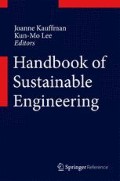Abstract
The twentieth century saw remarkable progress in scientific technology that our way of life was drastically transformed; the products humans made and the processes used to manufacture them had a considerable effect on the natural environment. Being aware of this, manufacturers are now trying to develop and commercialize manufacturing processes that produce as little environmental impact as possible (“cleaner production”). In addition, manufacturers are conducting life-cycle assessments (i.e., assessments of the product’s whole lifespan from cradle to grave) that specify processes that are considered to have the least environmental impact and maximum “eco-efficiency.” However, these techniques cannot be properly evaluated unless attempts are made to understand what is presently unknown with the use of social science, corporate ethics, and science and technology. Even when these concepts are established, there is still a long way to go before theory can be put into practice. Since 1994, the Study on the Introduction and Promotion of Design for Environment (DfE) techniques has studied the evaluation criteria for environmentallyconscious products in Japan. After studying this aspect until the end of the twentieth century, the study continued to develop and examine techniques for DfE. In the twenty-first century, as a final step to developing activities associated with DfE, the development of a technique called QFDE (Quality Function Deployment for Environment) was completed.
This chapter presents a methodology to apply Quality Function Deployment (QFD) for environmentally conscious design in the early stage of product development. This methodology has been developed by incorporating environmental aspects into QFD to handle the environmental and traditional product quality requirements simultaneously. “QFD for Environment (QFDE)” proposed consists of four phases. Designers can find out which parts are the most important parts to enhance environmental consciousness of their products by executing QFDE Phase I and Phase II. Further, a methodology to evaluate the effects of design improvement on environmental quality requirements was developed as Phase III and Phase IV. The results obtained from the case study of IC package show that QFDE could be applicable in the early stage of assembled product design, because the most important component from the viewpoint of the environment is clearly identified and multiple options for design improvement are effectively evaluated.
Access this chapter
Tax calculation will be finalised at checkout
Purchases are for personal use only
References
Y. Akao, Quality Function Deployment (Productivity Press, Cambridge, 1990)
P. Eagan, M. Finster, Creating business value by linking industrial ecology with business strategy and product design, in Second International Symposium on Environmentally Conscious Design and Inverse Manufacturing (EcoDesing2001) (IEEE Computer Society, Los Alamitos, 2001), pp. 842–847
K. Ishii, Design for Manufacturability: Product Definition. Course Reader for ME217 (Stanford University, Stanford, 1997)
P. Jean, R. Coulon, D. Timmons, Building an EcoDesign toolkit for the electronics industry, in First International Symposium on Environmental Conscious Design and Inverse Manufacturing (EcoDesign ’99) (IEEE Computer Society, Los Alamitos, 1999), pp. 701–706
OECD, Extended Producer Responsibility: A Guidance Manual for Governments (OECD Publishing, Paris, 2001)
B. Rapoza, T. Harjula, W.A. Knight, G. Boothroyd, Product design for disassembly and environment, Ann. CIRP 45, 109–112 (1996)
A. Stevels, Green marketing of consumer electronics, in Joint International Congress and Exhibition Electronics Goes Green 2000+ (VDE, Berlin, 2000), pp. 539–544
UNEP, ECODESIGN: a promising approach to sustainable production and consumption, United Nations Publication (1997)
Author information
Authors and Affiliations
Editor information
Editors and Affiliations
Rights and permissions
Copyright information
© 2013 Springer Science+Business Media Dordrecht
About this entry
Cite this entry
Masui, K. (2013). Environmental Quality Function Deployment for Sustainable Products. In: Kauffman, J., Lee, KM. (eds) Handbook of Sustainable Engineering. Springer, Dordrecht. https://doi.org/10.1007/978-1-4020-8939-8_91
Download citation
DOI: https://doi.org/10.1007/978-1-4020-8939-8_91
Publisher Name: Springer, Dordrecht
Print ISBN: 978-1-4020-8938-1
Online ISBN: 978-1-4020-8939-8
eBook Packages: EngineeringReference Module Computer Science and Engineering

